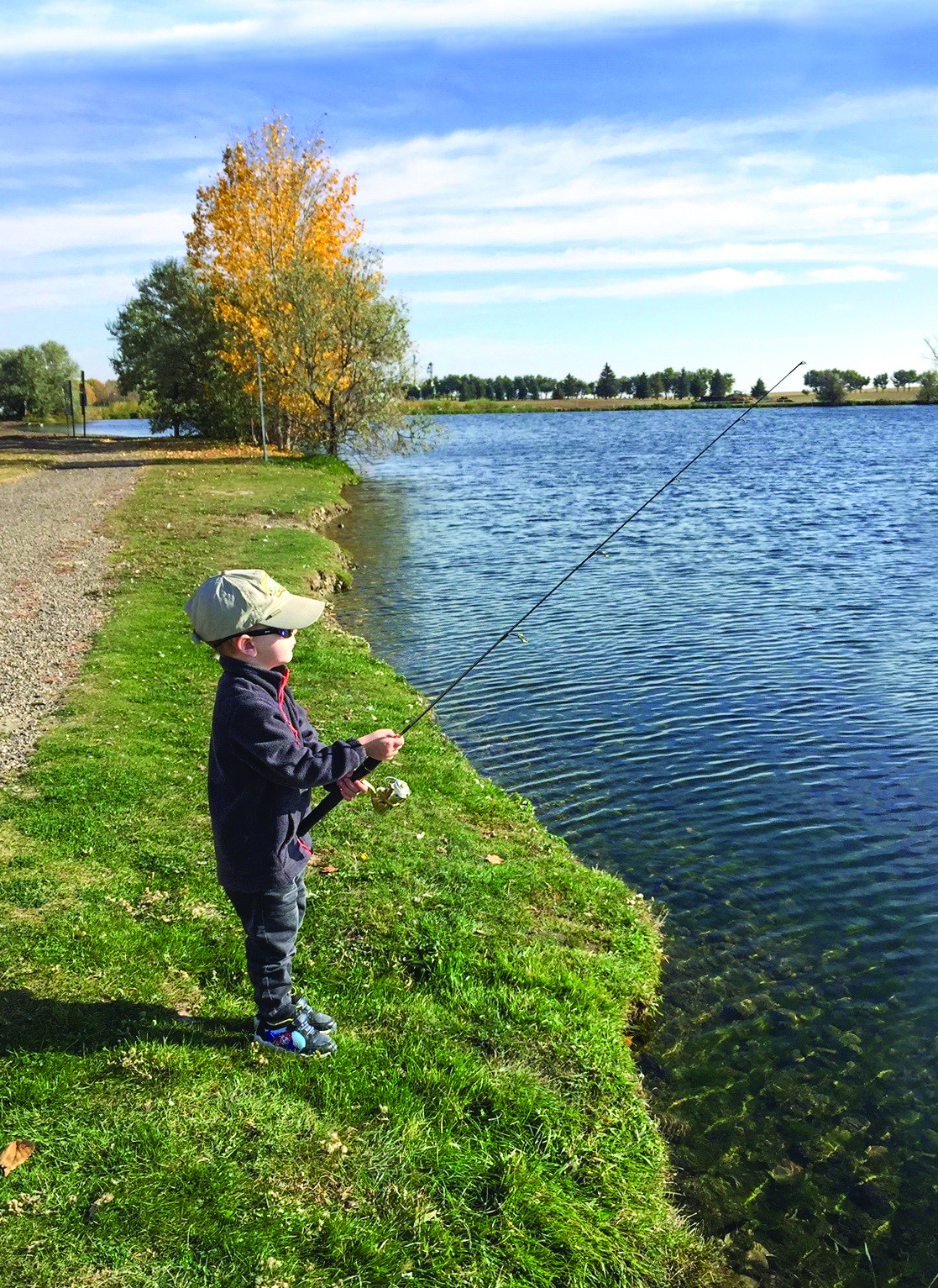
5 minute read
Irrigating the land, cultivating the fishing spirit
article and photos by Richard Phillips
What do Lake McGregor; Lake Newell; and Chin, Keho, Park, and Payne lakes have in common? Great fishing for sure, but they’re also all irrigation reservoirs—not natural lakes.

As a young angler from Lethbridge, I had no idea that many of my favourite fishing lakes were really irrigation reservoirs. Catching rainbow trout, pike, and perch at reservoirs helped make me a fishing fanatic. Decades later, I continue to make memories on reservoirs, including watching my young grandsons catch their first fish last summer. As general manager of the Bow River Irrigation District (BRID) I appreciate the primary role of reservoirs in irrigation, but I often find myself thinking of them as fisheries first when I am on the water.

Irrigation has been integral to southern Alberta for over a century, bringing water to a dry landscape to create stable food production, thousands of jobs, and billions of dollars of annual economic benefit.
Irrigating Alberta
Ten irrigation districts in southern Alberta drawing water from the Bow, Oldman, Waterton, Belly, and St. Mary rivers; and one tiny district reliant on Gros Ventre Creek near Medicine Hat combine to irrigate over 1.5 million acres of farmland. As most of the natural flow in these rivers comes from mountain snowmelt, irrigation infrastructure developers realized reservoirs were essential to ensure adequate water supplies throughout the growing season. The first large reservoirs, Newell and McGregor, were completed in 1914. Today there are over 40 reservoirs owned by irrigation districts, plus 11 more owned by the Government of Alberta that support irrigation districts. These reservoirs cover a vast area from Chestermere Lake near Calgary to Payne Lake near Mountain View and Cavan Lake east of Medicine Hat, which includes 8,000 kilometres of canals and buried pipelines.

The Benefits
Along with creating great fisheries and providing habitat for waterfowl and other wildlife in a region where natural fishbearing lakes are practically non-existent, every reservoir provides at least one of three intended benefits:
1. Short-term water storage to alleviate seasonal supply variability.
2. Longer term water storage for drought mitigation.
3. Flow regulation to improve water delivery efficiency.
The first two benefits are obvious, the third perhaps less so. In a typical irrigation district, water is diverted from a river into a main canal which feeds smaller canals and pipelines. Water in canals typically flows at under three kilometres per hour, so it takes several days for water from the river to reach the end of a large district. Farmers must order water in advance to ensure it is at their pumps when needed, but unpredictable weather can make it difficult to forecast how much water will be required. Strategically located balancing reservoirs break long canals into shorter segments to reregulate flow, reducing delivery times to farmers and providing just the right amount of water. These balancing reservoirs are also great for anglers, providing fisheries at more locations.


Fishing the Reservoirs
Common sport fish species in reservoirs include northern pike, walleye, lake whitefish, burbot, and yellow perch. Rainbow trout are regularly stocked in two reservoirs plus several ponds fed by irrigation infrastructure, including Alberta Conservation Association (ACA) projects such as McVinnie, McQuillan, and Enchant Park Pond. Pike and burbot inhabit the source rivers and naturally populated reservoirs, whereas walleye and whitefish were initially stocked in some reservoirs to create self-sustaining populations. Thanks to movement of fish in canals between reservoirs, stocking one reservoir creates populations in others. In addition to creating reservoir habitat, districts also work with ACA and Ducks Unlimited Canada to provide water for dozens of wildlife habitat projects and wetlands covering over 80,000 acres.
The irrigation districts welcome anglers and other recreational users but ask everyone to be vigilant to avoid introducing or spreading aquatic invasive species (AIS), and to respect district access policies and land. The districts are especially concerned about the threat of zebra and quagga mussels and have provided funding to Alberta Environment and Protected Areas for use in their AIS prevention program. Many reservoirs have excellent boat launches and popular campgrounds; these include Little Bow Provincial Park on Travers Reservoir, Kinbrook Island Provincial Park on Lake Newell, Golden Sheaf Park on Sauder Reservoir, and Rolling Hills Reservoir, Forty Mile Reservoir, and Crawling Valley Reservoir campgrounds.
The irrigation reservoirs provide easily accessible angling from shore, boat, or on the ice. It's often easy to land fish casting from shore. Good spots include along dams where crevices in rock riprap used to prevent erosion harbour prey for sport fish. Ideally though, a boat will expand fishing opportunities. I spend far more time in my lightweight 14-foot boat on reservoirs with limited access than in my larger boat. As teenagers, my brother and I caught countless pike fishing from our inflatable dinghy on Park Lake and other small reservoirs.
I love fly-fishing for trout in streams and mountain lakes, catching sturgeon and lake trout, northern fly-in trips, and salmon and halibut fishing in B.C., but the productivity, variety, and accessibility of Alberta’s irrigation reservoirs places them firmly among my favourite fishing destinations.

Meet Richard
Richard lives in Vauxhall, Alberta with his wife Karen, surrounded by great fishing and hunting opportunities. Born and raised in Lethbridge, he started fishing at about age five, and it is still his favourite recreational activity. After working for an engineering consulting firm in Calgary, he joined the BRID as district engineer in 1996 and was appointed general manager in 2004. Easy access to a wider variety of fishing opportunities was a definite factor in the decision to leave Calgary for Vauxhall.










